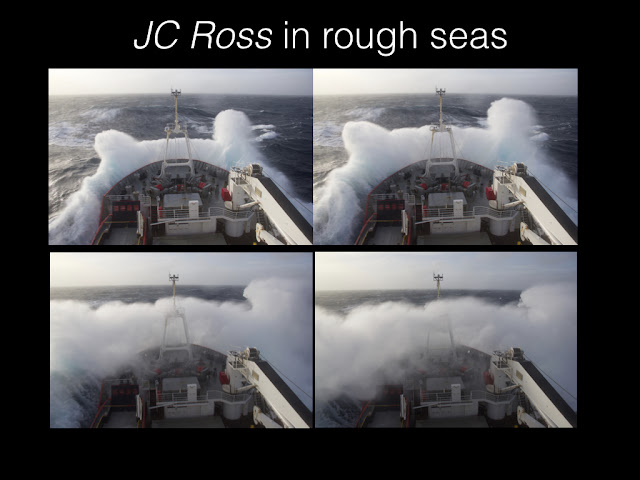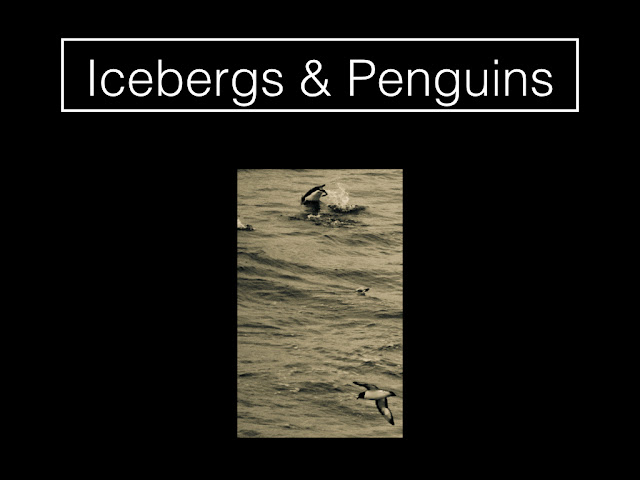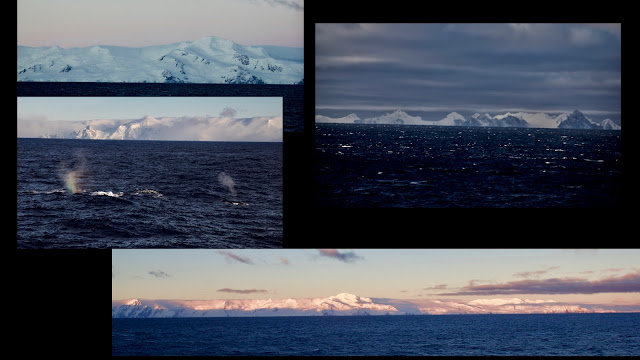This post is from Thursday, 4 May 2017 at 47S in the South Atlantic
The CTD cast numbered 120, taken to more than 5000 metres, was our final ocean measurement for the cruise. That happened on 1 May to the west of Coronation Island in the South Scotia Sea. Before I knew it, we had left the Scotia Sea and crossed north of the southern tip of South America as we ''steamed'' north towards Montevideo, Uruguay. We disembark in ''Monte'' and go our separate ways. Most will fly home. But others will do some touring around South America.
This post offers some experiences from our way north, as well as some personal reflections on this final leg of the cruise.
 |
| Sequence of photos from Monkey Island above the navigation bridge. The winds were roughly 50 knots and swells reaching eight metres (the next day we experienced 60 knot winds and 12 metre swell). It was quite a rush up there, to say the least, as the winds howled and the ship rocked and rolled. Paul, Eleanor, Rob, and I were having a wild ride. This wave in particular reached spray all the way to us, as did many others. Note that as the water rushed onto the deck, it soon drained off the ship, since all of the lower decks had the water-tight doors shut. |
Rough seas
Soon after we crossed the latitude of South America’s southern tip, it became clear that the mild weather experienced in recent weeks working in the Orkney Passage and Scotia Sea was in exchange for serious winds (upwards of 60 knots) and waves (upwards of 10 metre swells) on our way north. There are a couple of storms in our region, sending us rather interesting weather and huge waves for our transit. Last night was perhaps the toughest night of the cruise for sleep, at least for me. And now, writing this blog, I am looking at a seabird glide with the ship as it negotiates the swells. It seems unfazed by the massive weather happening all around.
Our steam north has been partly accompanied by westerly to northerly winds (i.e., winds from the west and north, blowing to the east and south). This wind alignment generally accords to the alignment of the waves and swells, though not always. When waves hit the ship from the front, the ship pitches up and down from the front to the rear. When waves hit the ship on the side, we roll left and right. Both motions are tough to negotiate when standing. But rolling can be tough even while seated.
My bed is oriented so that big rolls really make me move, sometimes prompting me to hold onto the mattress to keep me from falling out of bed. Indeed, at one point during the night, I nearly felt the bed release from underneath me, with air separating me from the mattress. I found myself becoming somewhat adept at anticipating a major pitch/roll event. A few minutes of quiet are inevitably followed by a major “hold on” event. A lifted ship will soon return down again, rocking and rolling as it settles into the waves.
Everything on my desk is inside the drawers. The cabinet doors are jammed shut with a piece of paper, so the doors will not slide open one way only to a moment later slide in the other direction. My cabin door jostles as if someone is trying to open it. While seated at my desk even now, with far fewer swells than last night, I sometimes need to hold onto the desk to avoid being thrown to the floor of sliding across the room.
 |
| Swell as seen from outside of the UIC. These swell reached upward of eight metres from crest to valley. Note the heavy winds ripping spray off the tops. |
Since we completed science measurements on 1 May, we have been holding an hour of science talks before dinner. I gave one on Tuesday, along with Jack. Yesterday was Christian’s turn, and today was for Alberto and Eleanor. These science talks have been an enjoyable opportunity to share our work and to field friendly, if not provocative, comments and suggestions. But the logistics are nontrivial when the ship is undergoing major motions. In the science library where we meet, there is a large table with chairs. During the talks, the speaker must remain seated in order to remain upright. At one point, a few of us rolled off chairs, falling flat, only to rise again as if nothing much had happened. It is amazing how a new norm can be defined among the chaos of a pitching and rolling ship.
 |
| Another sequence from Monkey Island. This wave really got us wet. |
For the family members reading this post, please note that these sorts of roiling seas may seem frightening. Indeed, they would be from smaller boat. But the JC Ross is incredibly stable. Motion is inevitable as we move through the swells and waves. It can make movement around the ship difficult to negotiate. But the motion is something to respect rather than to fear. I admit this statement is easier said than practiced. Nonetheless, I have learned to trust the ship after going through these storms during the cruise.
Engine room tour
 |
| Sandy, Alek, and Chris in the engine control room. It is really am impressive place, the heart of the ship's controls and functioning. (photo from Rob Templeton) |
Yesterday, 3 May, two of the ship’s engineers (Chris and Steve) gave eight of us a tour of the engine room and other machinery on the ship. It was an impressive display of machinery, design, and hard work. We got to see the propeller shaft; the incinerator; the many faces of the engines themselves; the control room, and places where “on the way” science instruments are stored. I quickly learned why so many of the ship’s crew have dirty hands and work clothes, as the spaces are tight and there are many opportunities to rub against greasy metal machines.
As well as being impressed by the engineering marvels of this ship, I garnered a greater appreciation for the work done by the ship’s crew, so much of it unseen by the scientists. These people do an amazing job of keeping us safe, comfortable, fed, and moving, while offering us the necessary tools to do science under incredibly difficult logistical situations.
 |
| Jack standing next to the propeller shaft. It is an amazingly quiet engine overall, due to some design features that promote the ship's use for biological oceanography where quiet is rather useful. Also note that the propeller can turn as slow as one revolution per minute. This rather slow speed is useful for doing the physical oceanography we conducted, where staying in one place or slowly moving forward or backward are rather important. (photo from Rob Templeton) |
The crew works for nearly four months at a time, supporting each of the different science teams that take the ship towards new locations for new tasks. The previous science team was largely a French group, and they spent most of their time near the ice in the southern part of the Weddell Sea. Our science team then took over in March for eight weeks. After reaching Montevideo, the crew will fly home, swapping chores with a new crew as the ship continues its missions into the Atlantic and the Arctic during the summer. It will then return to the south as the northern autumn arrives, pursuing yet more science in the Southern Ocean.
 |
| Sonya, Stephen, and Chris next to one of the engine room engines (I really do not know what we are looking at in detail, only that it is incredibly intricate and must be important!) (photo from Rob Templeton) |
The next few days
We should arrive to Montevideo late 7 May or early 8 May, weather and waves depending. We hope to reach calmer waters soon, especially by 6 May in time for an end of cruise barbecue planned for the back deck. Thoughts are now focused on ensuring all logistics for our transition to land-life are aligned. Thoughts are also spent digesting the many experiences of these weeks at sea.
This cruise has been an eye opener for me intellectually, exposing my science to new ways of thinking and doing. I have been like a kid in a candy store. This cruise has also impacted me personally. Work and life at sea are challenging, with longing for family and home an ever-present sense.
My exposure to unfiltered and raw natural forces was exhilarating, humbling, astonishing, and transformative. I have been in wilderness before. But not on a ship for eight weeks in the most remote and unforgiving ocean on the planet. This experience has taught me lessons about nature and self that will live on.
''Gratitude'' sums up my feelings now. Gratitude that my body, mind, and spirit supported this trip, and gratitude for my family supporting me as well. Gratitude for Alberto gifting me with a spot on this cruise as a ''floater'' scientist. And gratitude at experiencing, at least for some moments, the Southern Ocean in a manner that goes well beyond words, photos, or mental constructs. The steam towards Montevideo is the end of one long journey, but the beginning of others to come.
 |
| Another photo of the seas seen the past three days during the northward steam in the South Atlantic. |
 |
Stephen Griffies, in a photo from Coronation Island a day prior to leaving the Southern Ocean. The seas were much calmer there than on the way north to Montevideo!
|


















































